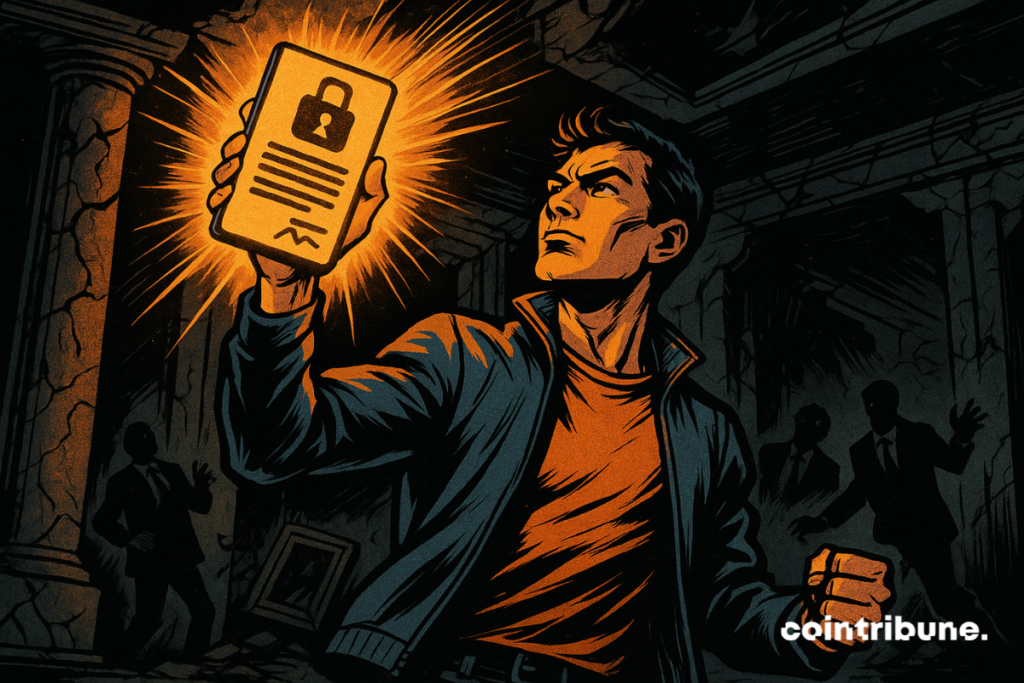Lending DeFi: Credit Reinvented By Blockchain
Imagine borrowing 10,000 euros without going through a bank, without a credit file, without an interview with an advisor. Just you, your crypto-assets, and an algorithm that decides in a few seconds. That is exactly what the lending markets of decentralized finance (DeFi) offer.

In brief
- DeFi allows borrowing without a bank, using crypto-assets as collateral.
- The RealToken Money Market transforms tokenized real estate into a liquidity source.
- Understanding the indicators (LTV, Health Factor) is essential to avoid liquidation.
Credit without a banker—it’s possible
With over $15 billion locked in decentralized lending protocols, this technology has become the backbone of the DeFi ecosystem. Giants like Aave and Compound to specialized solutions like the RealToken Money Market (RMM), these automated platforms are revolutionizing our relationship with credit.
In this article, we will explore how these decentralized lending markets work, including an explanation of the RMM which allows the use of tokenized real estate as collateral. Whether you are new to DeFi or an experienced investor, you will discover how these tools can transform your financial strategy.
How do lending markets work?
The principle in 3 simple steps
A DeFi lending market works like an automated bank but without traditional intermediaries. The process takes place in three steps:
1. Deposit collateral
You start by depositing crypto-assets you own—Bitcoin, Ethereum, stablecoins, or even real estate tokens. These assets serve as collateral for your future loan.
2. Borrow against this collateral
The protocol authorizes you to borrow an amount lower than the value of your collateral. If you deposit €1,000 of Ethereum, you will generally be able to borrow €750 in stablecoins (according to a 75% ratio).
3. Repay or be liquidated
You repay your debt whenever you want, thus recovering your collateral. If the value of your collateral drops too much, the protocol automatically sells it to repay the lenders.
The three actors of the system
This mechanism involves three types of users who operate the ecosystem:
- Lenders provide liquidity by depositing their assets into pools. In return, they receive interest paid by borrowers.
- Borrowers obtain liquidity without selling their positions, especially useful to keep high-potential assets.
- Liquidators maintain system stability by intervening when a position becomes risky, in exchange for a reward.
The 3 essential indicators to master
To navigate smoothly in a lending market, three metrics are crucial:
LTV (Loan-to-Value)
This is the maximum percentage you can borrow relative to your collateral. An ETH at €3,000 with an 80% LTV allows you to borrow up to €2,400. The riskier the asset is considered, the lower this ratio is.
Health Factor (HF)
This indicator summarizes the health of your position. Above 1, you are safe. Below, you risk liquidation. An HF of 1.5 means your collateral can lose 33% of its value before reaching the danger zone.
Liquidation threshold
This is the critical level at which the protocol automatically sells your collateral. If you borrow €750 against €1,000 of ETH, your position will be liquidated if ETH drops below a certain threshold (usually around €800-850 depending on the protocol’s parameters).
Concrete example
Sarah deposits 2 ETH (€6,000) and borrows €4,000 in USDC. Her initial LTV is 67% and her Health Factor is 1.5. If ETH drops to €2,250, her HF approaches 1 and she risks liquidation. She must then either repay part of her debt or add collateral.
RealToken Money Market: When real estate meets DeFi
A revolutionary concept
The RealToken Money Market (RMM) represents a major innovation in the French DeFi ecosystem. Developed by the RealT team, this protocol allows using tokenized real estate as collateral to borrow stablecoins.
RealT tokenizes American real estate properties, enabling investors to buy fractions of assets via RealTokens. Each token represents a share of ownership and generates rental income distributed daily. The RMM goes further by turning these illiquid assets into usable collateral to obtain liquidity.
Built on the proven foundations of Aave v3, the RMM benefits from the full technical robustness of DeFi lending leader while specializing in tokenized real estate. This “white label” approach combines innovation and security.
Complete practical case
Let us take the example of Marie, an investor who owns €15,000 of RealTokens spread across several properties in Medellín and Cleveland. These tokens yield about 8% annual rental income.
The situation: Marie wishes to invest in a promising crypto opportunity but does not want to sell her well-performing RealTokens. With the RMM, she can:
- Deposit her RealTokens as collateral on the platform
- Borrow €10,000 in USDC (conservative ratio of 67%)
- Keep her rental income while having fresh liquidity
- Invest the borrowed USDC in the identified opportunity
The advantages:
- No forced sale of her real estate assets
- Retention of rental income (8% annually)
- Immediate liquidity without friction
- Tax optimization (no taxable capital gains)
Technical specifics: The RMM uses technical wrappers that aggregate multiple RealTokens under a single representative token, bypassing Aave v3 limitations. For RealTokens used as collateral, a KYC process via a whitelisted wallet is required, complying with real estate asset regulations.
Specific risks to watch
Tokenized real estate presents unique characteristics:
- Limited liquidity: harder to sell quickly than ETH
- Complex valuation: depends on oracles and real estate appraisal
- Regulation: possible changes in the legal framework
- Geographical concentration: exposure to the U.S. real estate market
Marie must maintain a comfortable Health Factor (1.3-1.5) and monitor real estate price movements which impact her collateral.
Choose Your Platform: Aave, Compound, or Specialized Markets
Comparison of Main Solutions
| Criteria | Aave | Compound | RMM |
| Target Audience | Experienced DeFi Users | Beginners Seeking Simplicity | Tokenized Real Estate Investors |
| Supported Assets | 15+ cryptos on 8 blockchains | 10+ mainstream cryptos | RealTokens + stablecoins |
| Features | Flash loans, eMode, isolation | Basic but robust | Wrappers, dedicated liquidation |
| Complexity | High | Low | Moderate |
Aave is suited for advanced users who want access to a wide range of assets and sophisticated features. Its efficiency modes (eMode) allow higher LTVs between correlated assets.
Compound favors simplicity with a clean interface and transparent mechanics. Ideal for starting out with classic assets (ETH, WBTC, stablecoins).
RMM is specifically aimed at holders of RealTokens who want to monetize their real estate assets without selling them.
Getting Started Guide
Checklist Before You Begin
- Understand the fees (Ethereum gas + interest)
- Set alerts for your Health Factor
- Start with small amounts
- Read the documentation of the chosen platform
- Plan a comfortable safety margin
Beginner Mistakes to Avoid
- Overleveraging your position: aiming for the maximum LTV is dangerous
- Ignoring volatility: cryptocurrencies can drop 20% in a day
- Forgetting the fees: Ethereum transactions sometimes cost €50-100
- Not monitoring: a drifting Health Factor can be costly
Essential Tools
- DeFi Pulse to track protocols and TVL
- DefiSafety to assess smart contract risks
- Zapper.fi to monitor your DeFi positions
- Discord/Telegram Alerts to be notified of HF changes
The golden rule remains caution: it is better to have a Health Factor at 1.5 than a sudden liquidation that can make you lose 10-15% of your collateral in penalties.
Risks and Future Prospects
Risks to Know
The DeFi lending markets, despite their sophistication, carry specific risks that must be fully understood:
Technical Risks
- Smart contract bugs: faulty code can lock or lose funds
- Oracle problems: an incorrect price can trigger unjustified liquidations
- Malicious governance: community votes can change parameters to your disadvantage
Economic Risks
- Stablecoin depeg: if USDC loses its peg, your debts explode
- Liquidity crisis: during stress periods, withdrawing funds may be impossible
- Price manipulation: prices on illiquid assets can be artificially inflated
How to Protect Yourself
Diversification is your best ally. Never put all your eggs in one basket: spread your positions across several established protocols. Limit the size of your positions to what you can afford to lose, and maintain active monitoring of the protocols you use.
For RMM specifically, the protocol’s relative youth requires increased caution. Start with small positions to familiarize yourself with the mechanics before increasing your exposure.
The Future of Decentralized Lending
The sector is rapidly evolving toward greater sophistication and specialization. Three major trends are emerging:
- Risk isolation is advancing with modes allowing certain assets to be borrowed against specific collateral, limiting contagion in case of issues with a particular asset.
- Diversification of collateral is accelerating: after tokenized real estate (RMM), we see protocols emerging that accept NFTs, governance tokens, or even future income as collateral.
- TradFi-DeFi integration is strengthening with bridges between traditional and decentralized finance, enabling the use of real assets (stocks, bonds) as DeFi collateral.
In Summary
Lending markets represent the most concrete realization of the DeFi promise: automating and democratizing access to credit. From the giant Aave to specialized solutions like RMM, these protocols offer a credible alternative to traditional banking services.
For holders of RealTokens, RMM opens unprecedented opportunities: turning real estate assets into liquidity without losing exposure to the real estate market or rental income. It is a revolution for wealth investors.
Key Points to Remember:
- Always start small and with established protocols
- Monitor your Health Factor like a hawk
- Diversify your positions and platforms
- Stay informed of regulatory and technical developments
DeFi lending is still in its infancy. With the arrival of new types of tokenized assets and continuous improvement of user experience, these tools will likely become as natural as using a credit card. The question is no longer if this revolution will happen, but how quickly you want to be part of it.
Maximize your Cointribune experience with our "Read to Earn" program! For every article you read, earn points and access exclusive rewards. Sign up now and start earning benefits.

The views, thoughts, and opinions expressed in this article belong solely to the author, and should not be taken as investment advice. Do your own research before taking any investment decisions.